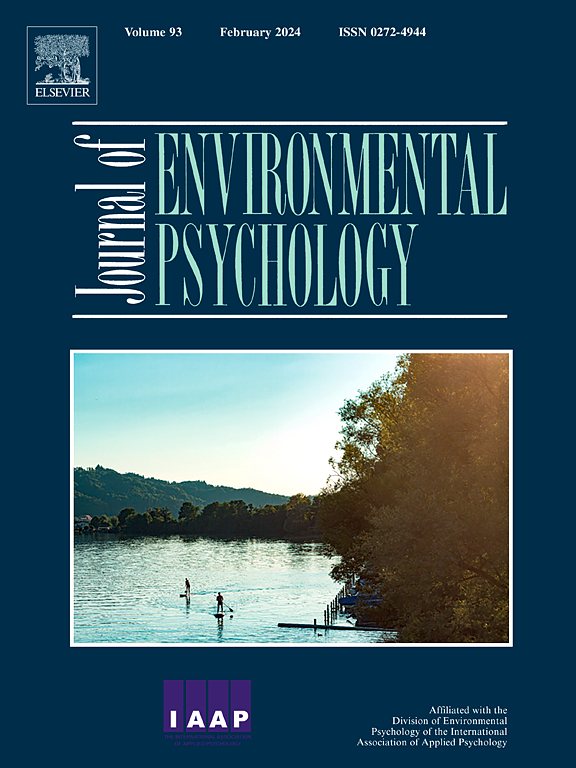比较自然和城市环境描绘的审美偏好和一致性评级
IF 7
1区 心理学
Q1 ENVIRONMENTAL STUDIES
引用次数: 0
摘要
研究表明,人们通常更喜欢自然环境而不是人造环境,假设生物对自然有准备。尽管存在不一致的地方,但在偏好评级方面的共识在比较面孔和抽象艺术方面的影响最大。本研究旨在评估一组显示自然环境和建筑环境的环境图像的一致性。我们假设,个体对自然环境的适应程度要高于对建筑环境的适应程度。98名参与者(其中69.4%是女性)使用人体自评量表对4个环境类别(各50个)中的200幅图像进行评价:非常自然的、中等自然的、中等建筑的和非景观的。一致性评分采用均值-1法进行评估。采用线性混合效应模型进行分析。结果显示,从放松到压力呈线性增长,对风景优美的自然环境的偏好从最不喜欢到最不喜欢,而不是中等风景优美的自然环境和中等风景优美的建筑环境到非常非风景优美的建筑环境。两组之间的一致性评分在效价上出现了显著差异,但与其他类别相比,只有中间风景建筑类别存在显著差异。对于唤醒,只有在非常风景的自然图像中,共识评级最低,一致性才有显著差异。对自然环境没有直观的共识,这与现有的发现相矛盾。本文章由计算机程序翻译,如有差异,请以英文原文为准。
Comparing aesthetic preferences and agreement ratings in depictions of natural and urban environments
Studies have shown that individuals usually prefer natural over built environments, assuming a biological preparedness for nature. Consensus in preference ratings has been reported, though with inconsistencies, with the largest effects in the comparison of faces and abstract art. The present study aimed to assess agreement in a set of environmental images displaying natural as well as built environments. We hypothesized that individuals would show greater agreement for the natural environment than for the built environment.
Ninety-eight participants (69.4 % of whom were female) rated 200 images from four environmental categories (50 each): very scenic natural, mid-scenic natural, mid-scenic built, and un-scenic built, with respect to valence and arousal using self-assessment-manikin rating-scales. Agreement ratings were assessed applying the mean-minus-1 method. Analyses were conducted with linear mixed-effects models. The results exhibit a linear increase from relaxing to stressful and most preferred to least preferred for very scenic natural images over mid-scenic natural and mid-scenic built to very un-scenic built environment. Significant differences in the agreement ratings between the groups emerged for valence, but only for the mid-scenic built category in comparison to the other categories. For arousal, agreement was significantly different only in the very scenic natural images with lowest consensus ratings. No intuitive agreement on natural environments emerged, contradicting existing findings.
求助全文
通过发布文献求助,成功后即可免费获取论文全文。
去求助
来源期刊

Journal of Environmental Psychology
Multiple-
CiteScore
10.60
自引率
8.70%
发文量
140
审稿时长
62 days
期刊介绍:
The Journal of Environmental Psychology is the premier journal in the field, serving individuals in a wide range of disciplines who have an interest in the scientific study of the transactions and interrelationships between people and their surroundings (including built, social, natural and virtual environments, the use and abuse of nature and natural resources, and sustainability-related behavior). The journal publishes internationally contributed empirical studies and reviews of research on these topics that advance new insights. As an important forum for the field, the journal publishes some of the most influential papers in the discipline that reflect the scientific development of environmental psychology. Contributions on theoretical, methodological, and practical aspects of all human-environment interactions are welcome, along with innovative or interdisciplinary approaches that have a psychological emphasis. Research areas include: •Psychological and behavioral aspects of people and nature •Cognitive mapping, spatial cognition and wayfinding •Ecological consequences of human actions •Theories of place, place attachment, and place identity •Environmental risks and hazards: perception, behavior, and management •Perception and evaluation of buildings and natural landscapes •Effects of physical and natural settings on human cognition and health •Theories of proenvironmental behavior, norms, attitudes, and personality •Psychology of sustainability and climate change •Psychological aspects of resource management and crises •Social use of space: crowding, privacy, territoriality, personal space •Design of, and experiences related to, the physical aspects of workplaces, schools, residences, public buildings and public space
 求助内容:
求助内容: 应助结果提醒方式:
应助结果提醒方式:


